bulb PONTIAC BONNEVILLE 2000 Owners Manual
[x] Cancel search | Manufacturer: PONTIAC, Model Year: 2000, Model line: BONNEVILLE, Model: PONTIAC BONNEVILLE 2000Pages: 402, PDF Size: 2.76 MB
Page 6 of 402

Table of Contents (cont'd)
Maintenance Schedule Service and Appearance Care
Section
7
Section
6
Scheduled Maintenance
Owner Checks and Services
Periodic Maintenance InspectionsRecommended Fluids and Lubricants
Maintenance Records
Fuel
Checking Fluids and Lubricants
GM Oil Life System™ (If Equipped)
Engine Air Cleaner/Fliter
Passenger Compartment Air Filter (If Equipped)
Brakes
Bulb ReplacementWindshield Wiper Blade Replacement
Tires and Wheels
Appearance Care
Electrical System/Fuses and Circuit Breakers
Capacities and Specifications
Normal Maintenance Replacement Parts
iv
Page 99 of 402
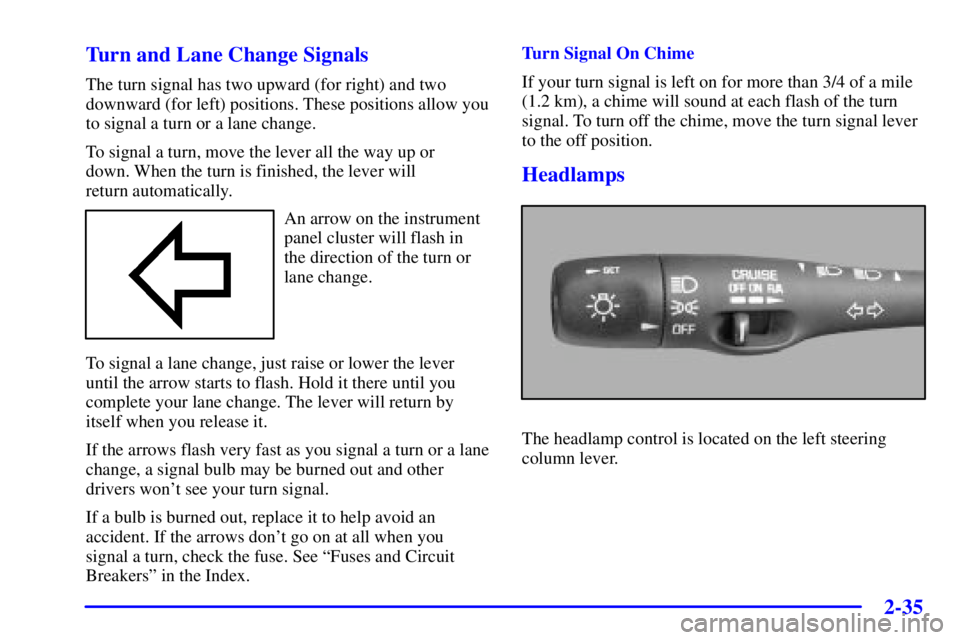
2-35 Turn and Lane Change Signals
The turn signal has two upward (for right) and two
downward (for left) positions. These positions allow you
to signal a turn or a lane change.
To signal a turn, move the lever all the way up or
down. When the turn is finished, the lever will
return automatically.
An arrow on the instrument
panel cluster will flash in
the direction of the turn or
lane change.
To signal a lane change, just raise or lower the lever
until the arrow starts to flash. Hold it there until you
complete your lane change. The lever will return by
itself when you release it.
If the arrows flash very fast as you signal a turn or a lane
change, a signal bulb may be burned out and other
drivers won't see your turn signal.
If a bulb is burned out, replace it to help avoid an
accident. If the arrows don't go on at all when you
signal a turn, check the fuse. See ªFuses and Circuit
Breakersº in the Index.Turn Signal On Chime
If your turn signal is left on for more than 3/4 of a mile
(1.2 km), a chime will sound at each flash of the turn
signal. To turn off the chime, move the turn signal lever
to the off position.
Headlamps
The headlamp control is located on the left steering
column lever.
Page 139 of 402
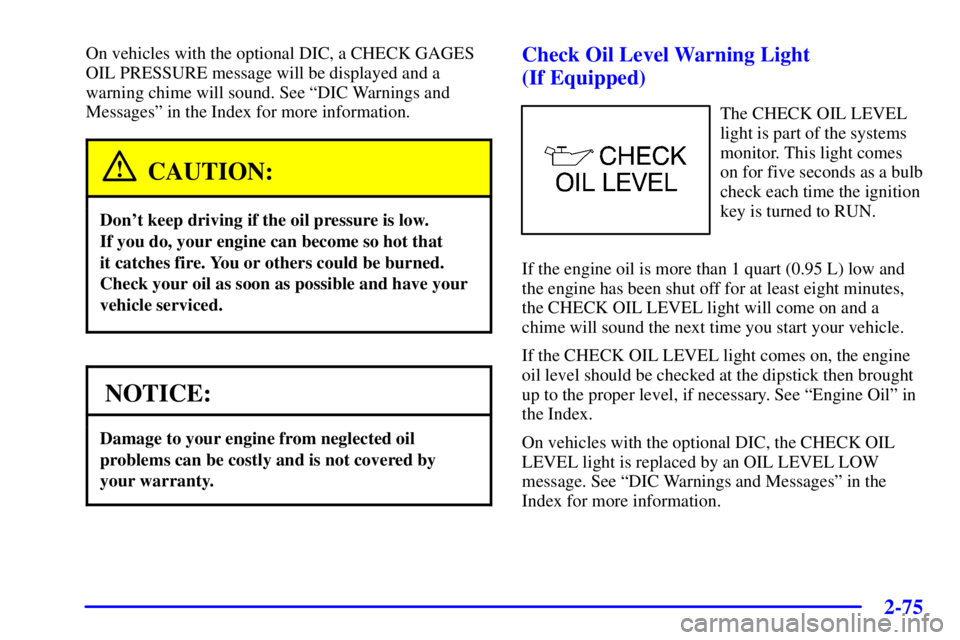
2-75
On vehicles with the optional DIC, a CHECK GAGES
OIL PRESSURE message will be displayed and a
warning chime will sound. See ªDIC Warnings and
Messagesº in the Index for more information.
CAUTION:
Don't keep driving if the oil pressure is low.
If you do, your engine can become so hot that
it catches fire. You or others could be burned.
Check your oil as soon as possible and have your
vehicle serviced.
NOTICE:
Damage to your engine from neglected oil
problems can be costly and is not covered by
your warranty.
Check Oil Level Warning Light
(If Equipped)
The CHECK OIL LEVEL
light is part of the systems
monitor. This light comes
on for five seconds as a bulb
check each time the ignition
key is turned to RUN.
If the engine oil is more than 1 quart (0.95 L) low and
the engine has been shut off for at least eight minutes,
the CHECK OIL LEVEL light will come on and a
chime will sound the next time you start your vehicle.
If the CHECK OIL LEVEL light comes on, the engine
oil level should be checked at the dipstick then brought
up to the proper level, if necessary. See ªEngine Oilº in
the Index.
On vehicles with the optional DIC, the CHECK OIL
LEVEL light is replaced by an OIL LEVEL LOW
message. See ªDIC Warnings and Messagesº in the
Index for more information.
Page 140 of 402

2-76
Service Vehicle Soon Light (If Equipped)
This light will come on
briefly as a bulb check
when your ignition is
turned to RUN.
This light will come on and a warning chime will sound
if you have a certain non
-emissions related vehicle
problem. These problems may not be so obvious and
may not affect vehicle performance or durability.
Consult a qualified dealership for necessary repairs to
maintain top vehicle performance.
On vehicles with the supercharged engine and the
optional DIC, the SERVICE VEHICLE SOON light is
replaced by the SERVICE VEHICLE SOON message.
See ªDIC Warnings and Messagesº in the Index for
more information.
Low Washer Fluid Warning Light
(If Equipped)
This light is part of the
systems monitor. It will
come on and a warning
chime will sound when the
washer fluid container is
less than one
-third full.
On vehicles with the optional DIC, the WASHER
FLUID light is replaced by the WASHER FLUID LOW
message. See ªDIC Warnings and Messagesº in the
Index for more information.
Page 141 of 402
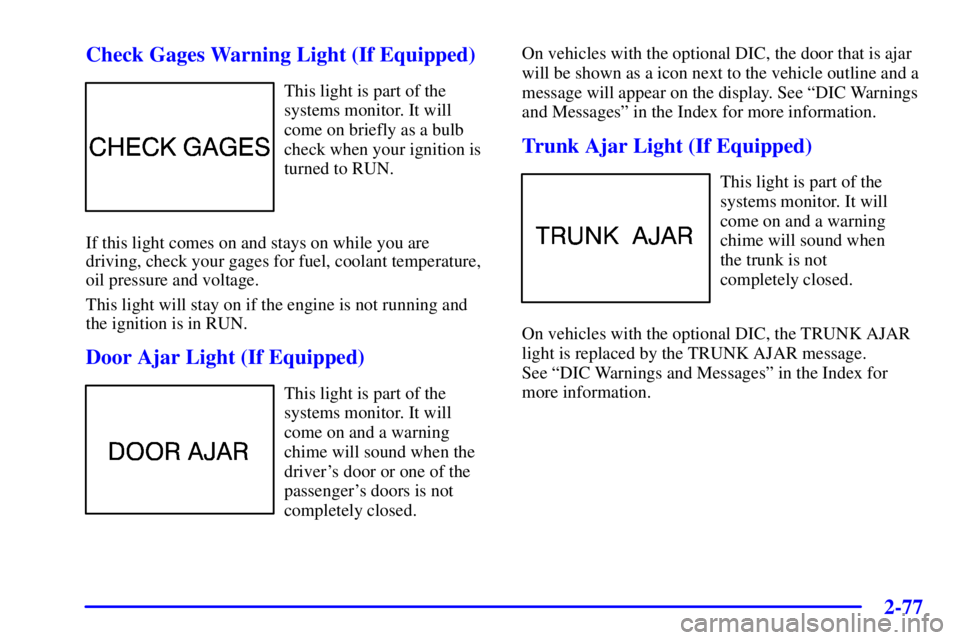
2-77 Check Gages Warning Light (If Equipped)
This light is part of the
systems monitor. It will
come on briefly as a bulb
check when your ignition is
turned to RUN.
If this light comes on and stays on while you are
driving, check your gages for fuel, coolant temperature,
oil pressure and voltage.
This light will stay on if the engine is not running and
the ignition is in RUN.
Door Ajar Light (If Equipped)
This light is part of the
systems monitor. It will
come on and a warning
chime will sound when the
driver's door or one of the
passenger's doors is not
completely closed.On vehicles with the optional DIC, the door that is ajar
will be shown as a icon next to the vehicle outline and a
message will appear on the display. See ªDIC Warnings
and Messagesº in the Index for more information.
Trunk Ajar Light (If Equipped)
This light is part of the
systems monitor. It will
come on and a warning
chime will sound when
the trunk is not
completely closed.
On vehicles with the optional DIC, the TRUNK AJAR
light is replaced by the TRUNK AJAR message.
See ªDIC Warnings and Messagesº in the Index for
more information.
Page 242 of 402
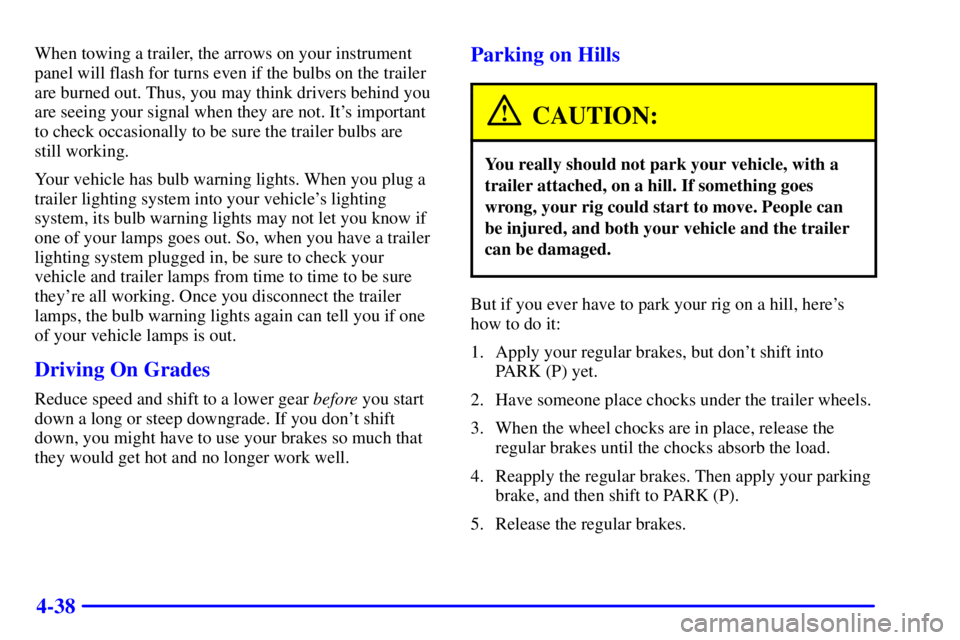
4-38
When towing a trailer, the arrows on your instrument
panel will flash for turns even if the bulbs on the trailer
are burned out. Thus, you may think drivers behind you
are seeing your signal when they are not. It's important
to check occasionally to be sure the trailer bulbs are
still working.
Your vehicle has bulb warning lights. When you plug a
trailer lighting system into your vehicle's lighting
system, its bulb warning lights may not let you know if
one of your lamps goes out. So, when you have a trailer
lighting system plugged in, be sure to check your
vehicle and trailer lamps from time to time to be sure
they're all working. Once you disconnect the trailer
lamps, the bulb warning lights again can tell you if one
of your vehicle lamps is out.
Driving On Grades
Reduce speed and shift to a lower gear before you start
down a long or steep downgrade. If you don't shift
down, you might have to use your brakes so much that
they would get hot and no longer work well.
Parking on Hills
CAUTION:
You really should not park your vehicle, with a
trailer attached, on a hill. If something goes
wrong, your rig could start to move. People can
be injured, and both your vehicle and the trailer
can be damaged.
But if you ever have to park your rig on a hill, here's
how to do it:
1. Apply your regular brakes, but don't shift into
PARK (P) yet.
2. Have someone place chocks under the trailer wheels.
3. When the wheel chocks are in place, release the
regular brakes until the chocks absorb the load.
4. Reapply the regular brakes. Then apply your parking
brake, and then shift to PARK (P).
5. Release the regular brakes.
Page 276 of 402
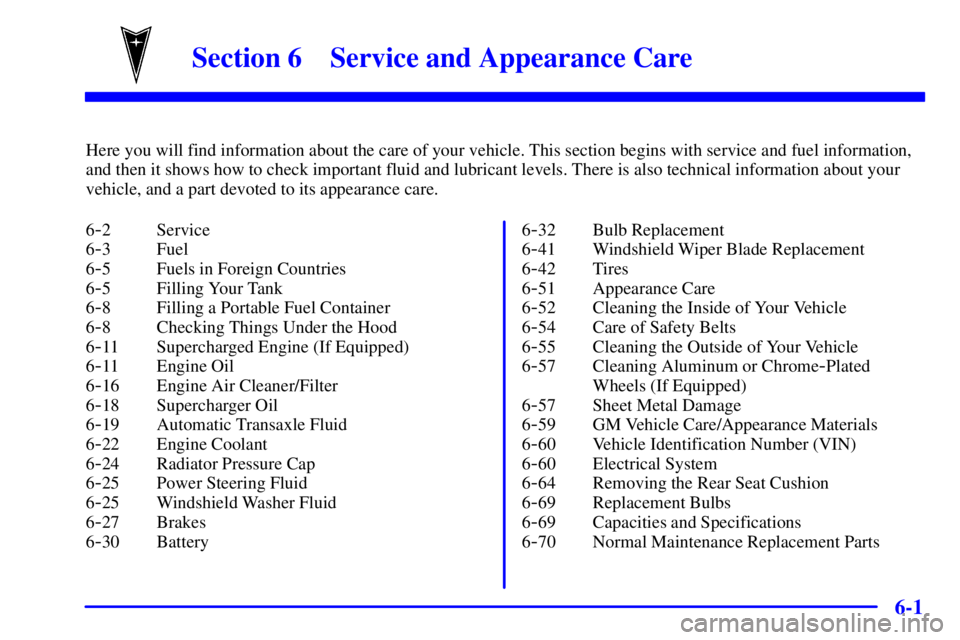
6-
6-1
Section 6 Service and Appearance Care
Here you will find information about the care of your vehicle. This section begins with service and fuel information,
and then it shows how to check important fluid and lubricant levels. There is also technical information about your
vehicle, and a part devoted to its appearance care.
6
-2 Service
6
-3 Fuel
6
-5 Fuels in Foreign Countries
6
-5 Filling Your Tank
6
-8 Filling a Portable Fuel Container
6
-8 Checking Things Under the Hood
6
-11 Supercharged Engine (If Equipped)
6
-11 Engine Oil
6
-16 Engine Air Cleaner/Filter
6
-18 Supercharger Oil
6
-19 Automatic Transaxle Fluid
6
-22 Engine Coolant
6
-24 Radiator Pressure Cap
6
-25 Power Steering Fluid
6
-25 Windshield Washer Fluid
6
-27 Brakes
6
-30 Battery6
-32 Bulb Replacement
6
-41 Windshield Wiper Blade Replacement
6
-42 Tires
6
-51 Appearance Care
6
-52 Cleaning the Inside of Your Vehicle
6
-54 Care of Safety Belts
6
-55 Cleaning the Outside of Your Vehicle
6
-57 Cleaning Aluminum or Chrome-Plated
Wheels (If Equipped)
6
-57 Sheet Metal Damage
6
-59 GM Vehicle Care/Appearance Materials
6
-60 Vehicle Identification Number (VIN)
6
-60 Electrical System
6
-64 Removing the Rear Seat Cushion
6
-69 Replacement Bulbs
6
-69 Capacities and Specifications
6
-70 Normal Maintenance Replacement Parts
Page 307 of 402
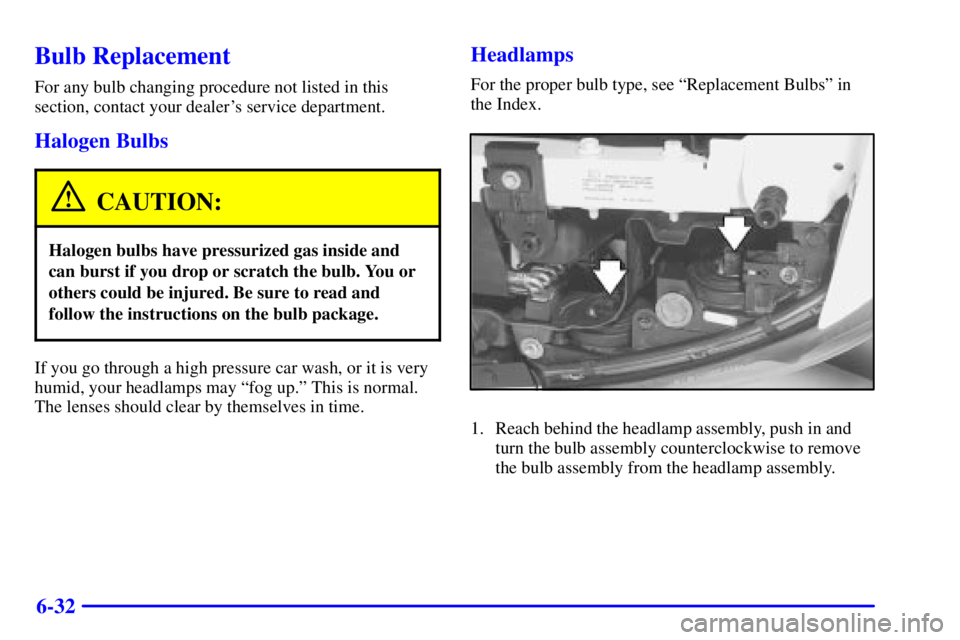
6-32
Bulb Replacement
For any bulb changing procedure not listed in this
section, contact your dealer's service department.
Halogen Bulbs
CAUTION:
Halogen bulbs have pressurized gas inside and
can burst if you drop or scratch the bulb. You or
others could be injured. Be sure to read and
follow the instructions on the bulb package.
If you go through a high pressure car wash, or it is very
humid, your headlamps may ªfog up.º This is normal.
The lenses should clear by themselves in time.
Headlamps
For the proper bulb type, see ªReplacement Bulbsº in
the Index.
1. Reach behind the headlamp assembly, push in and
turn the bulb assembly counterclockwise to remove
the bulb assembly from the headlamp assembly.
Page 308 of 402

6-33
2. Lift the tabs to remove the bulb from the assembly.
3. Replace the bulb. Push the bulb assembly in and turn
it clockwise to install the bulb assembly into the
headlamp assembly.Headlamp Aiming
Your vehicle has a visual optical headlamp aiming
system equipped with horizontal aim indicators. The
aim has been pre
-set at the factory and should need no
further adjustment. This is true even though your
horizontal aim indicators may not fall exactly on the ª0º
(zero) marks on their scales.
Page 314 of 402
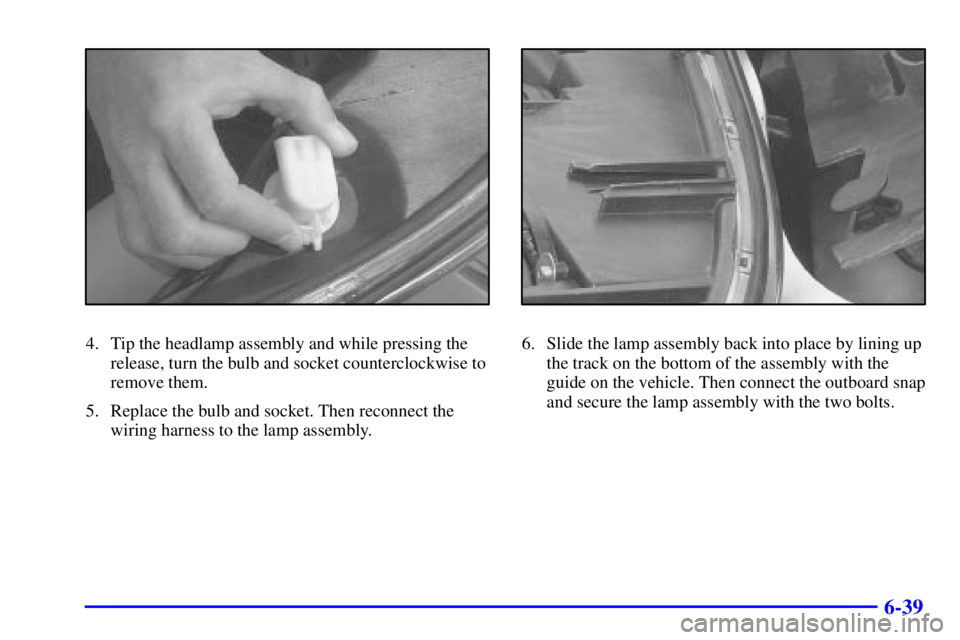
6-39
4. Tip the headlamp assembly and while pressing the
release, turn the bulb and socket counterclockwise to
remove them.
5. Replace the bulb and socket. Then reconnect the
wiring harness to the lamp assembly.6. Slide the lamp assembly back into place by lining up
the track on the bottom of the assembly with the
guide on the vehicle. Then connect the outboard snap
and secure the lamp assembly with the two bolts.